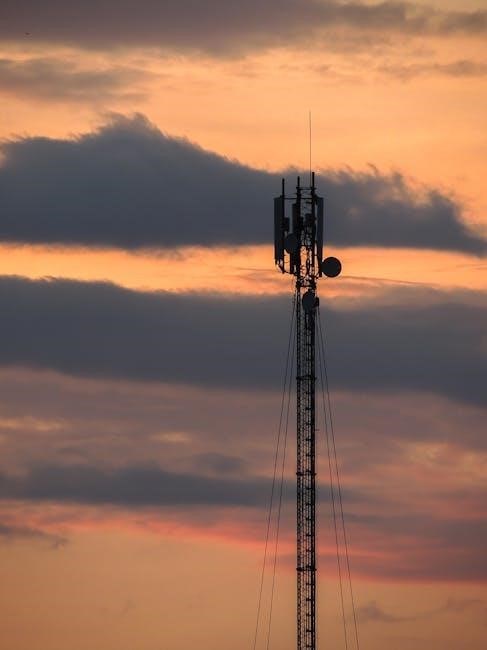Guide poles are essential structural components used to provide safety, direction, and control in various environments. They are widely used in construction, transportation, and public spaces to ensure order and safety.
1.1 Definition and Purpose of Guide Poles
Guide poles are vertical structures designed to provide clear directional guidance, safety, and control in various environments. Their primary purpose is to direct movement, ensure safety, and offer visual cues. They are commonly used in construction zones, parking areas, and public spaces to manage traffic flow and pedestrian movement efficiently. Guide poles play a crucial role in enhancing visibility and maintaining order.
1.2 Historical Background of Guide Poles
The use of guide poles dates back to ancient times, with early civilizations employing wooden posts for directional purposes. Over centuries, their design evolved, with metal poles becoming prevalent in the 19th century. The 20th century saw the introduction of reflective materials and standardized designs, enhancing their functionality in transportation and urban planning. Their historical development reflects advancements in safety and infrastructure.

Types of Guide Poles
Guide poles come in fixed, removable, and adjustable designs, each serving specific purposes in construction, events, or dynamic environments, ensuring versatility and practicality for diverse applications.
2.1 Fixed Guide Poles
Fixed guide poles are permanently installed structures designed to provide consistent direction and support. They are commonly used in construction zones and public areas to ensure safety and maintain order. Constructed from durable materials like steel or aluminum, these poles are sturdy and long-lasting, offering reliable guidance in various environments.
2.2 Removable Guide Poles
Removable guide poles are temporary structures designed for flexibility in various settings. Often used in events or temporary construction zones, they are lightweight and easy to install, making them ideal for short-term applications. Constructed from materials like aluminum or steel, these poles can be quickly moved or repositioned as needed, offering versatility without compromising safety or functionality.
2.3 Adjustable Guide Poles
Adjustable guide poles are versatile structures designed for dynamic environments. They feature mechanisms that allow height modification, making them ideal for temporary or changing settings. Commonly used in construction zones and event management, these poles provide flexibility while maintaining safety and directional guidance. Their adaptability ensures they meet varying needs efficiently without compromising stability or functionality.
Materials Used for Guide Poles
Guide poles are made from durable materials like steel, aluminum, and composites; These materials ensure strength, durability, and resistance to harsh environmental conditions for long-lasting performance.
3.1 Steel Guide Poles
Steel guide poles are a popular choice due to their exceptional strength, durability, and resistance to harsh environmental conditions. They are widely used in construction and industrial settings, offering long-lasting performance; Steel poles can be galvanized or coated to enhance corrosion resistance, ensuring reliability in demanding applications. Their robust structure makes them ideal for supporting heavy loads and withstanding extreme weather conditions.
3.2 Aluminum Guide Poles
Aluminum guide poles are lightweight, corrosion-resistant, and highly durable, making them ideal for various applications. They are often used in public areas and transportation due to their visibility and ease of installation. Aluminum poles are also low maintenance and can withstand harsh weather conditions, making them a practical choice for both temporary and permanent setups.
3.4 Composite Guide Poles
Composite guide poles are a modern alternative, offering exceptional durability and resistance to environmental factors. Made from materials like fiberglass and polymer, they are lightweight yet strong, ideal for harsh conditions. Their low maintenance and long lifespan make them a cost-effective solution for industrial and public settings, ensuring reliability and stability over time.

Applications of Guide Poles
Guide poles are widely used in construction zones, industrial areas, and public spaces to ensure safety, control traffic flow, and provide clear directional guidance for pedestrians and vehicles.
4.1 Construction Sites
Guide poles are crucial in construction zones for ensuring safety and organizing workflows. They are used to manage pedestrian and vehicle traffic, mark restricted areas, and provide mounting points for safety signs and lights. Durable and visible, these poles enhance site safety by clearly delineating pathways and hazards, reducing accidents and improving overall site efficiency in dynamic construction environments.
Their reflective markings and sturdy design make them ideal for harsh conditions, ensuring visibility even in low-light settings. By guiding workers and equipment effectively, guide poles play a vital role in maintaining order and safety on busy construction sites, adapting to the evolving needs of the project environment.
4.2 Industrial Settings
In industrial settings, guide poles play a key role in optimizing workflows and ensuring safety. They are used to direct workers, mark pathways, and manage equipment. Made from robust materials, their durability and visibility make them essential for maintaining order in busy environments, enhancing overall operational efficiency and contributing to a safer workplace.
4.3 Public Areas
Guide poles are widely utilized in public areas to enhance safety and organization. They serve as directional markers, crowd control barriers, and informational signs, ensuring smooth traffic flow and pedestrian navigation.
Mounted with reflective materials or integrated technology, these poles improve visibility and provide essential guidance in parks, plazas, and urban spaces, contributing to a safer and more orderly public environment for everyone.

Design and Installation
Guide pole design prioritizes durability, visibility, and functionality, with materials chosen based on environmental conditions. Installation involves precise placement, ensuring stability and alignment for optimal performance and safety.
5.1 Key Design Considerations
Key design considerations for guide poles include material selection, height, visibility, and durability. They must withstand environmental conditions and ensure clear visibility, often incorporating reflective markings or lighting. The design should also account for load-bearing capacity and stability, with secure anchoring to prevent tipping or damage. Proper spacing and alignment are crucial for effective guidance and safety in various applications.
5.2 Installation Process
The installation of guide poles involves site preparation, anchoring, and securing the pole. Ensure the ground is level and clear of debris. Anchor the pole using concrete footings for stability. Align the pole vertically and tighten all bolts. Apply reflective markings for visibility. Conduct final inspections to ensure proper alignment and safety compliance. Regular checks post-installation are recommended.

Safety Features of Guide Poles
Safety features of guide poles include reflective markings, safety caps, and visibility enhancements to ensure clear visibility and prevent accidents in low-light conditions and crowded areas.
6.1 Reflective Markings
Reflective markings on guide poles enhance visibility, especially in low-light conditions, by using materials that reflect light. They are strategically placed to ensure clear visibility for drivers and pedestrians, reducing accidents and improving safety in both urban and rural areas. Regular maintenance of these markings is crucial to maintain their effectiveness and ensure continuous safety benefits.
6.2 Safety Caps
Safety caps are essential accessories for guide poles, designed to protect against sharp edges and prevent injuries. Made from durable materials like rubber or plastic, they provide a safe barrier while maintaining visibility. Bright colors or reflective elements enhance their effectiveness, ensuring they are easily noticeable. Regular inspections and replacements are recommended to uphold safety standards and prevent accidents.
6.3 Visibility Enhancements
Visibility enhancements for guide poles include the use of high-visibility paints, LED lighting, and reflective materials to ensure they are easily noticeable in various conditions. These features are crucial for maintaining safety and direction in busy or low-light environments. Additionally, some guide poles incorporate smart technology to adapt visibility based on environmental factors effectively.

Maintenance and Repair
Regular inspections and timely repairs are crucial to ensure guide poles remain functional and safe. Proper maintenance extends their lifespan and prevents potential hazards in public areas.
7.1 Regular Maintenance
Regular maintenance ensures guide poles remain durable and functional. This includes inspecting for damage, cleaning surfaces, and checking hardware integrity. Lubricating moving parts and repainting worn areas prevents deterioration and maintains visibility, ensuring safety and longevity.
7.2 Repair Techniques
Repair techniques for guide poles involve assessing damage, straightening bent poles, and replacing damaged signs or reflective components. Securing loose bases and refinishing surfaces are common practices. Specialized tools may be used for alignment, while durable materials ensure longevity. Regular repairs maintain safety and functionality, adhering to safety standards and extending the pole’s service life effectively.
Guide Poles in Transportation
Guide poles play a crucial role in transportation by providing safety, direction, and control. They are used to direct traffic, prevent accidents, and enhance visibility in public transport hubs.
8.1 Roadside Guide Poles
Roadside guide poles are critical for ensuring traffic safety and order. They are strategically placed along highways, near traffic lights, and in construction zones to provide clear direction and control. Featuring reflective markings and durable materials like steel or aluminum, these poles enhance visibility and prevent accidents, especially in low-light conditions. They are essential for maintaining smooth traffic flow and ensuring pedestrian safety in high-risk areas.
8.2 Guide Poles in Public Transport
Guide poles play a vital role in public transport systems, ensuring safety and order. Installed at bus stops, train stations, and airports, they help manage queues, direct passengers, and prevent overcrowding. Often equipped with reflective markings and clear signage, these poles enhance visibility and provide essential information, making them indispensable for efficient and secure public transportation environments.
Guide Poles in Temporary Structures
Guide poles in temporary structures are essential for crowd control and safety. They are lightweight, easy to install, and ideal for events or construction zones.
9.1 Temporary Guide Poles
Temporary guide poles are lightweight and portable, designed for short-term use in events, construction zones, or emergency situations. They are easy to install and relocate, ensuring safety and organization without permanent installation. Made from durable yet flexible materials, they often feature reflective markings for enhanced visibility and can be adjusted to suit various temporary needs, providing effective crowd control and directional guidance.
9.2 Portable Guide Poles
Portable guide poles are lightweight and compact, designed for easy transport and quick setup. Often used in temporary events or emergency response, they feature collapsible or telescoping designs for convenient storage. Made from durable materials like aluminum or fiberglass, they are equipped with high-visibility safety caps and reflective tape, ensuring clear directional guidance in dynamic environments while maintaining portability and flexibility for various applications.
Guide Poles and Urban Planning
Guide poles play a crucial role in urban planning by enhancing safety, organization, and aesthetics in public spaces, while supporting city infrastructure and development.
10.1 Role in Urban Development
Guide poles significantly contribute to urban development by organizing traffic flow, providing public information, and ensuring pedestrian safety. They enhance city infrastructure by offering clear directional guidance and integrating with smart city technologies, thus supporting sustainable and efficient urban growth while improving overall urban aesthetics and accessibility for residents and visitors alike.
10.2 Integration with City Infrastructure
Guide poles seamlessly integrate with city infrastructure, complementing urban planning by providing directional guidance, traffic control, and public information. They are strategically installed alongside roads, railways, and public transport hubs, enhancing the functionality of these systems. Their design and materials often align with urban aesthetics, ensuring they blend into the environment while serving essential purposes for both residents and visitors.

Guide Poles in Emergency Services
Guide poles play a crucial role in emergency services by providing clear pathways and essential information, aiding responders in efficiently locating sites and saving time during crises.
11.1 Emergency Guide Poles
Emergency guide poles are vital in crisis situations, providing clear pathways and critical information for first responders. They enhance visibility with reflective markings and safety caps, ensuring quick access to emergency sites and minimizing risks during nighttime or low-light conditions.
11.2 Emergency Response Applications
Guide poles play a crucial role in emergency response by providing visible markers for first responders. They help direct personnel to emergency locations efficiently, ensuring timely action. Reflective markings and clear signage enhance visibility, while durability ensures reliability in crisis situations. Their strategic placement aids in navigating challenging environments, making them indispensable for emergency services.

Guide Poles and Technology
Guide poles are increasingly integrated with technology, such as smart sensors and IoT devices, to enhance functionality and real-time data collection for improved efficiency and safety.
12.1 Smart Guide Poles
Smart guide poles incorporate advanced technologies like sensors, IoT connectivity, and data analytics to enhance functionality. They can monitor traffic flow, environmental conditions, and provide real-time information, improving safety and efficiency in urban and transportation settings. These poles often feature energy-efficient lighting and can integrate with smart city systems, making them versatile tools for modern infrastructure needs.
12.2 Integration with IoT
Integration with IoT enables guide poles to connect with smart city infrastructure, enhancing real-time data collection and communication. Sensors embedded in poles monitor traffic, weather, and environmental conditions, transmitting data to central systems. This connectivity improves traffic management, public safety, and energy efficiency, while supporting urban planning and emergency response applications, making guide poles integral to modern, connected cities.

Environmental Impact
Guide poles can have environmental implications, but eco-friendly materials and sustainable practices reduce their carbon footprint, promoting greener urban and industrial landscapes while minimizing ecological disruption.
13.1 Eco-Friendly Guide Poles
Eco-friendly guide poles are made from sustainable materials like recycled steel or aluminum, reducing environmental impact. They often feature solar-powered lighting, minimizing energy consumption. These poles promote green spaces and urban sustainability while maintaining functionality, making them ideal for environmentally conscious cities and projects focused on reducing carbon footprints and enhancing energy efficiency.
13.2 Sustainable Materials
Sustainable materials for guide poles include recycled steel, aluminum, and composites. These options reduce environmental impact by minimizing resource depletion and lowering carbon emissions. Composite materials, made from recycled plastics and natural fibers, offer durability while being eco-conscious. Bamboo is another sustainable option, providing a renewable resource for guide poles, especially in urban landscapes aiming to promote green infrastructure and environmental stewardship.

Regulations and Standards
Regulations and standards for guide poles ensure safety and durability. They include international codes and local laws, specifying design, material, and installation requirements to meet safety standards and engineering practices.
14.1 International Standards
International standards for guide poles ensure uniformity in design, safety, and durability across global markets. Organizations like ISO and ASTM develop these standards, addressing material quality, load-bearing capacity, and installation practices. Compliance with these standards ensures products meet rigorous testing and performance criteria, guaranteeing reliability and safety for diverse applications worldwide.
14.2 Local Regulations
Local regulations for guide poles vary by region and often dictate specific requirements such as material usage, height restrictions, and installation practices. Compliance with local zoning laws and permits is crucial to ensure safety and legal adherence. These regulations may also include maintenance standards to uphold community safety and aesthetic norms.
Guide poles play a vital role in ensuring safety, direction, and control across various environments. From construction sites to public spaces, their versatility and essential features make them indispensable. With advancements in materials and technology, guide poles continue to evolve, offering smarter and more sustainable solutions. Their proper installation, maintenance, and adherence to regulations ensure they remain a cornerstone of modern infrastructure and urban development.
